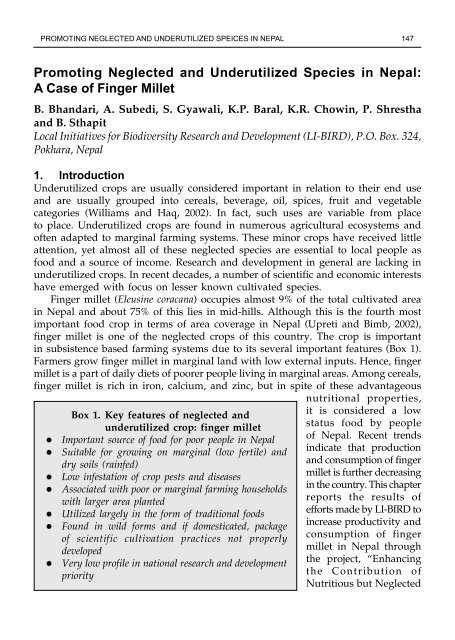Minor millets in South Asia: learnings from IFAD-NUS project in India ...
Minor millets in South Asia: learnings from IFAD-NUS project in India ...
Minor millets in South Asia: learnings from IFAD-NUS project in India ...
Create successful ePaper yourself
Turn your PDF publications into a flip-book with our unique Google optimized e-Paper software.
promot<strong>in</strong>g negleCted and underutilized speiCes <strong>in</strong> nepal 147<br />
Promot<strong>in</strong>g Neglected and Underutilized Species <strong>in</strong> Nepal:<br />
A Case of F<strong>in</strong>ger Millet<br />
B. Bhandari, A. Subedi, S. Gyawali, K.P. Baral, K.R. Chow<strong>in</strong>, P. Shrestha<br />
and B. Sthapit<br />
Local Initiatives for Biodiversity Research and Development (LI-BIRD), P.O. Box. 324,<br />
Pokhara, Nepal<br />
1. Introduction<br />
Underutilized crops are usually considered important <strong>in</strong> relation to their end use<br />
and are usually grouped <strong>in</strong>to cereals, beverage, oil, spices, fruit and vegetable<br />
categories (Williams and Haq, 2002). In fact, such uses are variable <strong>from</strong> place<br />
to place. Underutilized crops are found <strong>in</strong> numerous agricultural ecosystems and<br />
often adapted to marg<strong>in</strong>al farm<strong>in</strong>g systems. These m<strong>in</strong>or crops have received little<br />
attention, yet almost all of these neglected species are essential to local people as<br />
food and a source of <strong>in</strong>come. Research and development <strong>in</strong> general are lack<strong>in</strong>g <strong>in</strong><br />
underutilized crops. In recent decades, a number of scientific and economic <strong>in</strong>terests<br />
have emerged with focus on lesser known cultivated species.<br />
F<strong>in</strong>ger millet (Eleus<strong>in</strong>e coracana) occupies almost 9% of the total cultivated area<br />
<strong>in</strong> Nepal and about 75% of this lies <strong>in</strong> mid-hills. Although this is the fourth most<br />
important food crop <strong>in</strong> terms of area coverage <strong>in</strong> Nepal (Upreti and Bimb, 2002),<br />
f<strong>in</strong>ger millet is one of the neglected crops of this country. The crop is important<br />
<strong>in</strong> subsistence based farm<strong>in</strong>g systems due to its several important features (Box 1).<br />
Farmers grow f<strong>in</strong>ger millet <strong>in</strong> marg<strong>in</strong>al land with low external <strong>in</strong>puts. Hence, f<strong>in</strong>ger<br />
millet is a part of daily diets of poorer people liv<strong>in</strong>g <strong>in</strong> marg<strong>in</strong>al areas. Among cereals,<br />
f<strong>in</strong>ger millet is rich <strong>in</strong> iron, calcium, and z<strong>in</strong>c, but <strong>in</strong> spite of these advantageous<br />
nutritional properties,<br />
Box 1. Key features of neglected and<br />
underutilized crop: f<strong>in</strong>ger millet<br />
Important source of food for poor people <strong>in</strong> Nepal<br />
Suitable for grow<strong>in</strong>g on marg<strong>in</strong>al (low fertile) and<br />
dry soils (ra<strong>in</strong>fed)<br />
Low <strong>in</strong>festation of crop pests and diseases<br />
Associated with poor or marg<strong>in</strong>al farm<strong>in</strong>g households<br />
with larger area planted<br />
Utilized largely <strong>in</strong> the form of traditional foods<br />
Found <strong>in</strong> wild forms and if domesticated, package<br />
of scientific cultivation practices not properly<br />
developed<br />
Very low profile <strong>in</strong> national research and development<br />
priority<br />
it is considered a low<br />
status food by people<br />
of Nepal. Recent trends<br />
<strong>in</strong>dicate that production<br />
and consumption of f<strong>in</strong>ger<br />
millet is further decreas<strong>in</strong>g<br />
<strong>in</strong> the country. This chapter<br />
reports the results of<br />
efforts made by LI-BIRD to<br />
<strong>in</strong>crease productivity and<br />
consumption of f<strong>in</strong>ger<br />
millet <strong>in</strong> Nepal through<br />
the <strong>project</strong>, “Enhanc<strong>in</strong>g<br />
the Contribution of<br />
Nutritious but Neglected

















